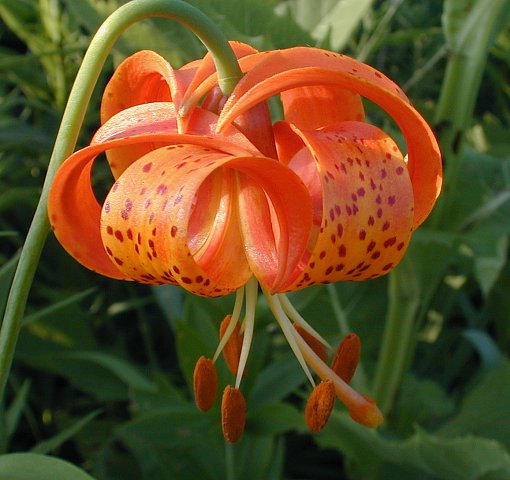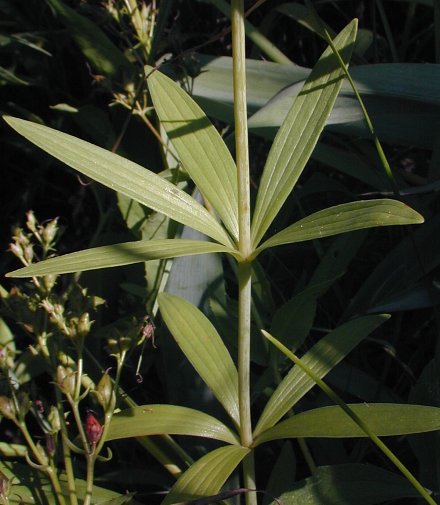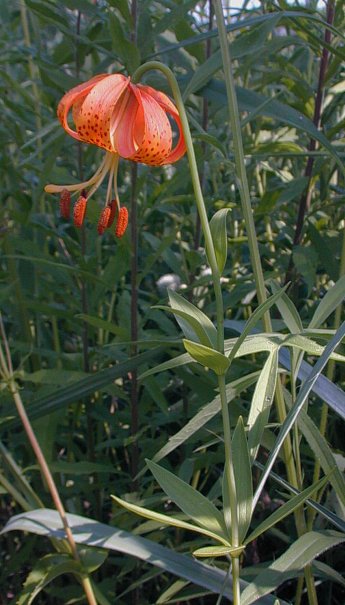Description: This perennial plant is 1½–4' tall, more or less erect, and unbranched. The central stem is light to medium green, terete, glabrous, and sometimes glaucous. The leaves usually occur in whorls of 3-7 along the stem, although some of the upper leaves may occur in pairs or they may alternate individually. Individual leaves are 2½–5" long and ¼–¾" across; they are elliptic in shape, smooth (entire) along their margins, and sessile or nearly so. Leaf venation is parallel. The upper leaf surface is medium green and glabrous, while the lower leaf surface is light-medium or whitish green, glabrous, and sometimes glaucous. Above the terminal leaves of the central stem, there are 1-6 nodding flowers on stalks about 4-8" long (one flower per stalk). These stalks are erect or ascending; they are light to medium green, terete, glabrous, and sometimes glaucous. Each showy flower is about 2-3" long and similarly across, consisting of 6 tepals, 6 stamens, and a pistil with a single style. The tepals are yellow-orange to orange-red, purple-spotted, lanceolate in shape, and strongly recurved; the tips of the tepals are located near the base of the flower. The stamens are strongly exserted and slightly spreading; their filaments are light green to nearly white, while their anthers are reddish brown, oblongoid or ellipsoid in shape, and less than ½" in length. The style is strongly exserted and curved slightly upward; it is light yellow to nearly white, except toward the slightly swollen tip, where it is tinted yellow to orange-red.

The blooming period occurs from early to mid-summer,
lasting about 1 month. There is no noticeable floral scent. Afterwards,
the flowers are replaced by seedpods. These seedpods are about 1½"
long, oblongoid in shape, 3-celled, and glabrous; they split open into
3 parts to release their seeds. Mature seeds are brown, flattened,
ovate-deltate in shape, and strongly winged along their margins. The
thin papery wings enable the seeds to be carried some distance by
gusts of wind. The root system consists of a yellow bulb with fibrous
roots below, from which clonal offsets with new bulbs may form.
Cultivation:
The preference is full to partial sun, loamy soil or sandy loam, and
moist
conditions. An established plant, however, can withstand some drought.
Cultivation from seed is slow and difficult, while cultivation from
bulbs or transplants is somewhat faster and easier. Plants
that are spoiled with too much fertilizer and watering may flop over.
Range & Habitat:
The native Michigan Lily occurs in scattered counties of
Illinois (see Distribution
Map), where it is uncommon. Habitats include moist black soil
prairies, openings in deciduous woodlands, typical thickets and sandy
thickets, Bur Oak savannas,
moist sandy meadows along rivers, swamps, fens, and prairie remnants
along
railroads. Michigan Lily is found in higher quality natural areas.

Faunal
Associations:
Cross-pollination is required for fertile seeds. The large showy
flowers appear to be designed to attract hummingbirds and larger
day-flying insects, such as Sphinx moths, Hummingbird moths (Hemaris spp.), and
the
larger butterflies. Robertson (1929) observed such butterflies as the
Monarch (Danaus plexippus),
Great Spangled Fritillary (Speyeria
cybele), and Spicebush Swallowtail (Papilio troilus)
visiting the flowers for nectar. Other insects feed destructively on
lilies (Lilium spp.).
These species include the Lily Leaf Beetle (Lilioceris lilii),
stem-boring larvae of the Burdock Borer Moth (Papaipema cataphracta),
stem-boring larvae of the Golden Borer Moth (Papaipema cerina),
larvae of the Narcissus Bulb Fly (Merodon
equestris), the Crescent-marked Lily Aphid (Aulacorthum circumflexum),
and the Tulip Bulb Aphid (Dysaphis
tulipae);
see Marshall (2006), Covell (1984/2005), Panzer et al. (2006), Cranshaw
(2004), and Blackman & Eastop (2013). Deer, rabbits, horses,
cattle, and other
livestock occasionally browse on the foliage, while voles sometimes eat
the bulbs.
Photographic Location:
The photographs were taken at Meadowbrook Park in Urbana, Illinois,
and a wildflower garden at the Anita Purves Nature Center of
the same city.

Comments: This is an attractive plant that can be cultivated in flower gardens. For many years, the Michigan Lily (Lilium michiganense) was not distinguished from the Turk's Cap Lily (Lilium superbum), even though there are several characteristics that can be used to distinguish them, including the following: 1) the Michigan Lily has a more northern distribution in Illinois than the latter, 2) the anthers of Michigan Lily are less than ½" in length, while the anthers of the latter species are ½" or longer and they are more slender in shape, 3) the tepals of Michigan Lily curve backward so that their tips are located near the base of the flower, while the tepals of Turk's Cap Lily curve backward so that their tips are located behind the base of the flower, 4) the Michigan Lily usually has yellow bulbs, while the latter lily usually has white bulbs, 5) Turk's Cap Lily sometimes has a 6-pointed green star on the throats of its flowers, while the flowers of Michigan Lily never have this characteristic, and 6) the Turk Cap's Lily is usually taller and it blooms less reliably than the Michigan Lily, at least in Illinois.